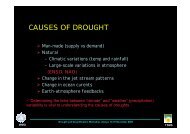Slayt 1 - RTC, Regional Training Centre - Turkey
Slayt 1 - RTC, Regional Training Centre - Turkey
Slayt 1 - RTC, Regional Training Centre - Turkey
You also want an ePaper? Increase the reach of your titles
YUMPU automatically turns print PDFs into web optimized ePapers that Google loves.
Additional Information: SimplifiedFinite Difference FormThe top finite difference equation can be converted into the form below it to explicitly show that we are solving for the future value ofq. This value depends on its current value and the moisture difference between the grid points to the east and west. This is illustratedconceptually in the bottom equation.While finite difference equations appear complex, they are relatively simple and fast for a computer to evaluate. The grid point modelstructure is then used so the equations can be solved in a straightforward way for every grid point to produce a weather forecast.Note that this is the simplest possible finite difference approximation for the original equation. In practice, more complex expressionsare used to increase the accuracy of the approximation. Typically, more grid points are also involved in the calculation of each term.Additionally, note that forecasters often calculate diagnostic quantities from model output as part of the forecasting process. Thesecalculations will not necessarily be the same as those performed by the forecast model itself, since some variables have been averagedduring model postprocessing. For instance, a complicated quantity such as potential vorticity, which requires an average of thegradients of winds and temperatures over several grid points, will appear to be smoother in the forecaster's diagnostic than was in factthe case in the forecast model itself.
















